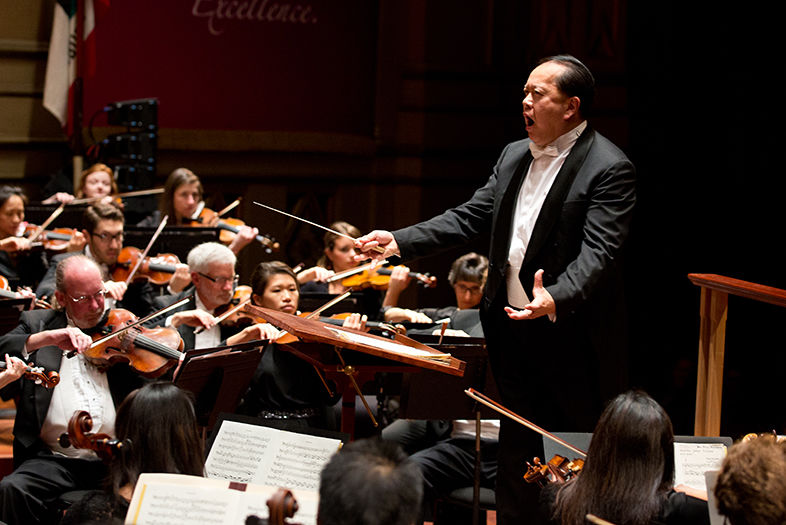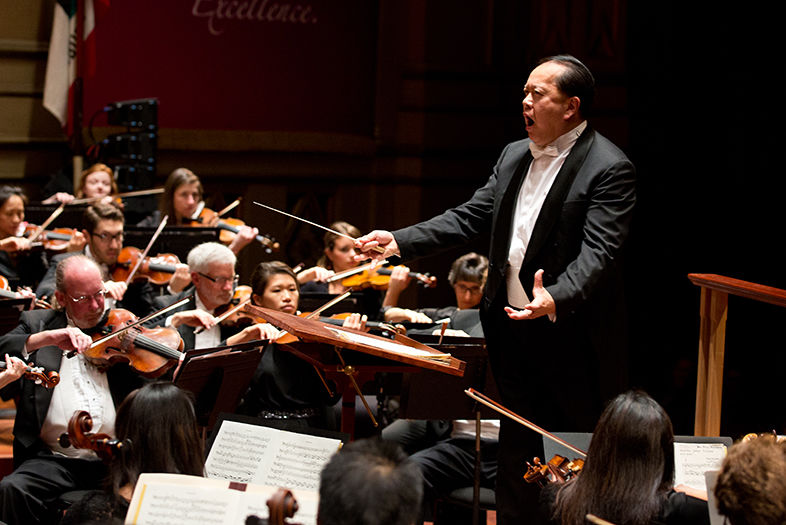Jahja Ling’s Finale
A Jacobs Masterworks Concert
May 26–28
Yefim Bronfman, piano
BRAHMS: Piano Concerto No. 2 in B-flat Major, Op. 83
SIBELIUS: Symphony No. 2 in D Major, Op. 43
During your 13-year tenure, you hired more than 65 musicians, 45 of whom currently perform.
We sometimes have 100 people auditioning for one position. After several rounds, they have one year of tenure when we watch them inside the orchestra, and we determine whether this person is qualified to stay or not. It’s a very rigorous process. The person has to be special and be able to blend with the orchestra. Let’s say you have ninety people on a stage—if everyone is playing on their own, they cannot produce a sound for the public that sounds like one.
Reviewing your 2013 Carnegie Hall performance, the New York Times said your symphony was made up of “noticeable numbers of younger players.” By young, did they mean green?
The right sound doesn’t come overnight—you have to continuously work with intonation, with ensemble, with rhythm, with balance, with the dynamic level. All those kinds of things take years to build, so that’s why great orchestras—Cleveland, Chicago, Boston, New York—have a long tradition of being trained to play like one unit. When I built this orchestra after the bankruptcy I tried to nurture these people, to inspire them to become one ensemble so they can play in the top, top level of professionalism.
How do you choose the music?
Well, when you eat food, you don’t want everything to be sweet, only dessert, or only salad, so we have a mixture of repertoire, like a balanced diet. Also, I choose what will appeal to the audience, because if the audience doesn’t like the program they won’t buy the tickets, right? But at the same time, you cannot just do all the popular work because very soon you run out of it. We also try to challenge the orchestra. You cannot repeat the same program over and over again, because then they don’t learn anything.
You’re the first and only conductor of Chinese descent to serve as music director of a major American orchestra. That’s surprising.
I was very blessed, because I grew up in Jakarta, Indonesia, of Chinese parents. The Dutch raided Indonesia for 300 years, so they left a lot of great classical music traditions there. When you grow up familiar with this temple of European tradition in your system, in your emotion, in your intellect, you understand how it should go. It’s like you’re speaking the language of your mother tongue. Being recognized for that and proving that I could combine the American and the European training—that’s why mentors like Lennie Bernstein, Kurt Masur, and Christoph von Dohnányi liked me, and why I’ve had the opportunity to conduct different orchestras. But without their endorsement and mentorship, it would have been impossible for me to break through the barrier.
Do you try to mentor more Asian conductors?
I try to pass on my tradition because I am an American. I came here in the 1970s. As an American I would like to pass on music to American musicians, and also to young Asian musicians; that’s why I travel to Asia all the time, and I travel in America all the time. Europe is a little bit different—they are protective. Hardly any Asian conductors would be able to have a career in Europe. It’s very difficult. So I have conducted there, but I will never be recognized as a music director in Europe. But in Asia, yes! In America, yes! I can be a music director because they look past race or ethnicity.
The symphony has started offering new programs like Jazz at the Jacobs and performing the soundtracks to movies like Wizard of Oz and Harry Potter. Is it a struggle to appeal to popular tastes while also staying true to the classics?
It is a struggle, because American culture is mostly pop culture. We produce so many pop singers and we have Hollywood. But I believe that the symphony orchestra’s main mission is to present the best classical music. We would like to present all genres of music, but the reason musicians go to conservatory is to play classical music. If we want to just present the music of Harry Potter or Star Wars, we don’t need an orchestra of this caliber. I like to present a balanced diet, but our main core is still classical music. It’s not San Diego Pop Orchestra.
Speaking of pop, you were on an album that went platinum.
I was the first conductor of a symphony orchestra ever invited to the Super Bowl. As the music director of the Florida Orchestra, I conducted the national anthem with Whitney Houston at Super Bowl XXV in Tampa. To this day, people say it was the best rendition of “The Star-Spangled Banner” ever performed.
Do you have a favorite memory? Carnegie Hall?
That might be the highlight. In its 102-year history, the orchestra had never played at Carnegie Hall and I was the first one to take them there, with Lang Lang. The concert was sold out and enthusiastically received. We also toured China, the first international tour the orchestra ever made. It was a landmark moment. But what I want to say is that San Diego Symphony is a part of the culture and tradition of serving the community. Those highlights—Carnegie Hall, China—just confirm that ours is a great orchestra that the community should treasure. We not only perform, we also reach out to young people in the area. Every year we bring over 60,000 kids to Symphony Hall. And our musicians go to schools to perform.
How often will you come back, as the symphony’s first conductor laureate?
I’ll conduct for at least two programs every year. I live in San Diego, but I’m not retiring. I’ll be traveling a lot with Stephen Tong Evangelistic Ministries International, which I cofounded and is based in Indonesia. They call Stephen Tong the Chinese Billy Graham. My second mission is to guest conduct different orchestras, mostly in America and Asia. But number three is to pass on my tradition to young people. I’ve been named Distinguished Principal Guest Artist at the Cleveland Institute of Music and I’ll be visiting other schools around the world.
Tell us about your finale this month.
I’ll be joined by one of my closest friends, Yefim Bronfman. He’ll come to play Brahms’s Piano Concerto No. 2 to celebrate my last concert. I’ll end the program with Sibelius’s Symphony No. 2, which I conducted in my debut with Cleveland, with Leipzig Gewandhaus, and with other orchestras around the world. It’s a piece that’s very close to me, so with that I will conclude my tenure as music director here.
The Ling Dossier
- Mentored by Leonard Bernstein, Kurt Masur, and Christoph von Dohnányi
- Conducted for Queen Elizabeth; performed with Tony Bennett and Mary Martin
- Conducted with Yo-Yo Ma
- Conducted the national anthem with Whitney Houston at Super Bowl XXV
- Gave Lang Lang his first solo engagement in a major orchestra at age 16
- Founded San Francisco and Cleveland’s youth orchestras
- Received an Emmy Award for his telecast “A Concert in Tribute and Remembrance” for 9/11
- Conducted SDS at Carnegie Hall
- Brought SDS to a Tier One major orchestra designation
- It’s pronounced “YA-yah”
- You can call him “maestro”

Jahja Ling’s Final San Diego Symphony Concert
Photo by David Hartig














